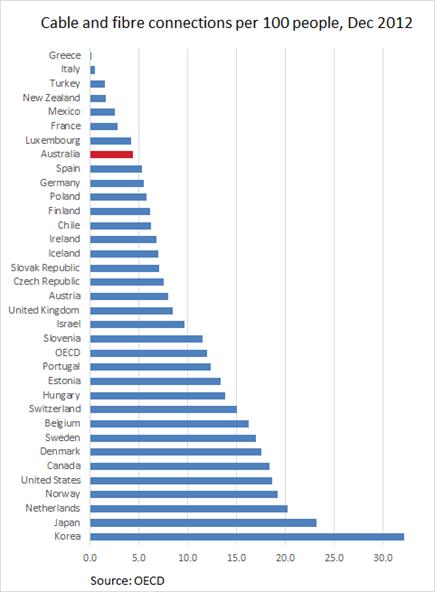Yet more bad news on Australian broadband speeds

It seems that almost every week, there is yet more data demonstrating how far Australia is falling behind on broadband. It's bad news for a country with such a revolutionary vision as the National Broadband Network (NBN).
The latest figures collated by the OECD (released July 18) show we are eighth from the bottom of member countries for fibre and cable penetration — just 4.4 per 100 inhabitants, compared to 36.5 in Korea and more than 18 in the US and Canada. The UK penetration is twice ours, even though the OECD definition of fibre doesn't include Openreach's fibre-to-the-node solution.
As a proportion of all broadband, our fibre penetration rate is just 1.58 percent, against an OECD average of 14.9 percent.
The reason for our poor showing is a no-brainer: It has to be the delayed investment resulting from the NBN. Although the Competitive Carriers Coalition also put it down to the dominant power of Telstra. "The apparent stagnation of the Australian broadband market is yet another symptom of insufficient market competition," it said, highlighting the need to fix the problem before we decline further in international rankings.
Frankly, we don't have too much farther to fall. Mexico is nipping at our heels. It's not a good look, although it's one that New Zealand has had to come to terms with.
As we reel from our poor showing on the fibre front, Akamai this week hit us with its latest State of the Internet report, covering the first quarter of 2013. It shows us as being eighth from the bottom of the OECD for average speed, at 4.7Mbps. If that speed seems low to you, check out my earlier explanation of how it measures stuff.
This latest data from Akamai shows that not only have we not moved up the ladder since the last report, but we're also in the bottom half of the table for growth — 11 percent up, compared to 21.4 percent in the UK.
So the vast majority of countries are faster than us, and more than half of them are piling on speed at a greater ratio than we are — even though we come from a low base. In other words, the gap is widening. For example, in the last quarter of 2012, the UK's average speed was 54 percent higher than us; now, its 68 percent. Last time, it had 11 percent of users above 10Mbps; this time, it's 20 percent. Over the same quarter, we've gone from 3.9 percent to 4.8 percent.
In summary, our slow speeds are growing slower than most, and, as we recently observed, we're paying more for the privilege.
But, it's not all bad news — Telstra's profits for the first half were up 8.8 percent.
At least some numbers are moving in the right direction.
